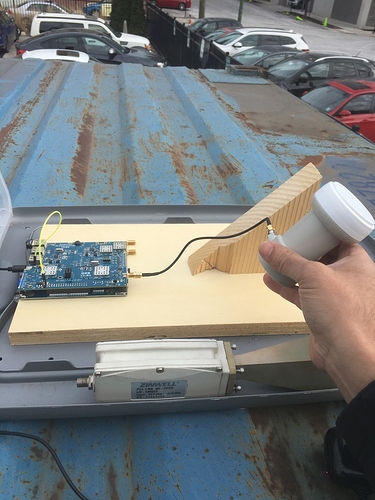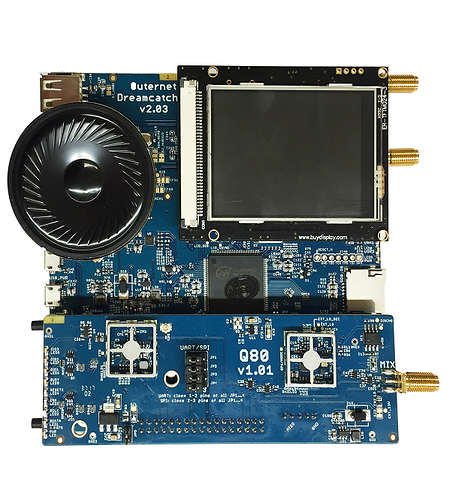Yes, that is a commercially available Ku-band LNB. No modifications were made to the “antenna” and I was catching packets as I took that picture. Our guess is that the horn on an LNB provides about 6 dBi of gain. We were pointed at Galaxy-28 and received at 30kbps. That is well over 10-times the throughput of L-band. This picture was taken today, but we’ve been link-testing since August.
So this is Outernet 3.0: Back to Ku, but with a much smaller antenna.
Our original network required a 60cm dish to receive a 100kbps data stream. 100kbps over the course of a day is 1GB of content, which is enough for all kinds of files, including video. And 1GB per day is plenty of to grow a local library. Although 30kbps is not even close to 100kbps, future network changes are not needed to increase performance. From here on out, we can make improvements to the network without needing to change the modem. Dreamcatcher 3v01 (prototype in background of picture) is what makes this all possible.
The fatter pipe makes a lot of things possible, one of which is a true radio broadcast. How about a national radio broadcast that isn’t SiriusXM? Our new receiver will include a speaker; audio through the speaker while files download in the background. But more data is not the most important thing that comes out of all this. The real win is that leasing standard, commodity Ku bandwidth is far, far more cost effective than the few kilohertz we have on L-band. Long-term sustainability of a free broadcast is no longer the financial burden that it once was–especially considering how much more interesting the service becomes.
But now for the bad news. We will be officially deprecating L-band on December 16th. This is going to be a hard reset for us, with the website completely changing and also with the store being temporarily unavailable. We will find alternative channels to sell various RF products, under a completely different brand, in order to prevent confusion.
I’m sure there will be very many questions and I’ll try to answer as many as possible. Regarding the secret sauce we are using to get packets down to a tiny Ku-antenna, I’m going to punt on those until the new beam is live. which will be right after the first (we would like to have receivers in stock when we make the announcement). I’m sure many of you will be able to figure out what we are doing once you see it in a spectrum analyzer, but until that time, it’s all open to speculation 
73,
Syed
KD9GII







